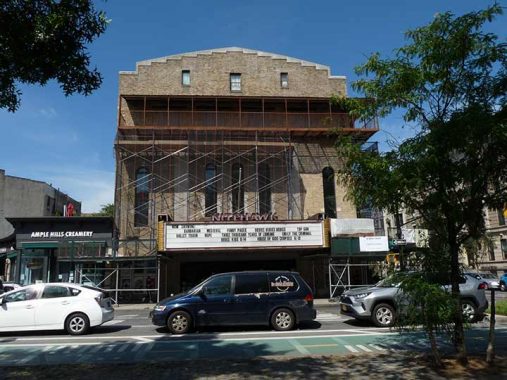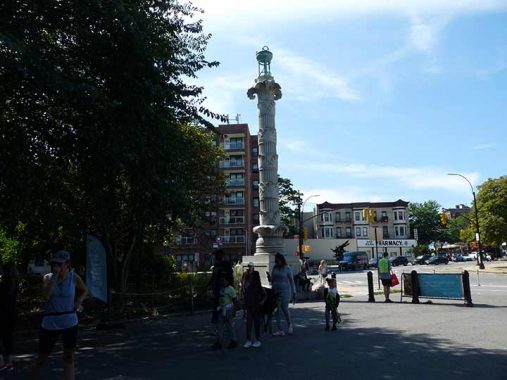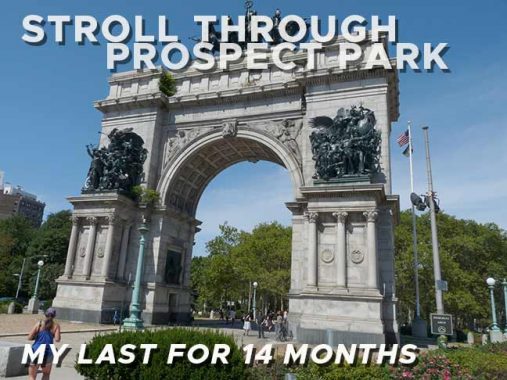
BACK In September 2022 I took a train to 15th Street/Prospect Park and walked through the park, eventually winding up at Barclays Center. I had been feeling “off” for awhile, with symptoms exacerbated after a couple hours on my feet, but didn’t think much of it till the discomfort became more and more acute, until I was in rather persistent pain that lasted 2 hours or more. Doctor after doctor couldn’t pinpoint the reason until a renal specialist was fairly confident that issue was due to a hernia pressing on the bladder and other parts “down there.” I finally got it repaired in Sept. 2023 and other than not yet being in shape for lengthy walks, I’ve been pain-free again. Why am I detailing it here? The reason is simple. Don’t take it for granted, being able to put one foot in front of the other thousands of times a day. It is a precious gift you have been given and your body, the universe, Fate, whatever, may be conspiring to take it away. Enjoy every second.
So, this was my final walk of any decent length until about 14 months later. (Recently I have been stymied more by miserable weekend weather than any physical ailment). It was a brilliant day but even in September, shadows were getting lengthy and harsh. The Independent Subway 15th Street-Prospect Park station opened on July 1, 1933. The stations are rather uniformly built, with streamlined Machine Age signage in various tile colors. However, subway design architect Squire Vickers did allow himself a little leeway with station entrances at parks, which do have some variation, such as the stone pillars and post-top lamps. In the 1980s, the lamps were given green colored globes which indicate the station can be entered 24/7. Tokens haven’t been needed since the late 1990s and soon, Metrocards will be supplanted by the OMNY system, enabling entrance with taps of a bank card or phone with the proper bank setup; OMNY cards will also be available.

The old Sanders Theater, which existed in ghost form when I rode past it in the 1970s on the way home from college; the theater was given new life, and 7 extra screens, as the Pavilion Theater in the 1990s. The Pavilion, which gained a reputation as one of the theaters indelicately called “The Itch” was revamped some years ago as The Nitehawk Cinema, which features drink and meal service at the right price level.
In 1996, my friend Brian B. maintains I was able to maneuver my way into the Pavilion without benefit of a ticket. This is nearly 30 years ago now so I forget how I did it. It was on Independence Day 1996 and we were seeing… “Independence Day.” Now that’s what I call a close encounter.

The Bartel-Pritchard traffic circle entrance to Prospect Park is marked by a pair of very tall acanthus-design columns, one of a pair inspired by the 400 B.C. Acanthus Column of Delphi, they feature granite acanthus leaves around the columns and on the capital, topped by bronze lanterns. They were designed by Stanford White in 1906, shortly before he was shot and killed by one Harry Thaw: White had cheated on his marriage in a dalliance with chorus girl Evelyn Nesbit, whom Thaw later married; Thaw killed White in a jealous rage.
These stoplights were installed in Prospect Park in the early 1990s in the years just before I left Brooklyn for Queens. I commonly bicycled Prospect Park, entering at Parkside and Ocean Avenue. Why there? I like to take my medicine early. The park drive is all uphill from there until Grand Army Plaza area, then flat along Prospect Park West, and then there’s a glorious downhill and you could fly all the way down to Park Circle at Coney Island Avenue, where I continued on back to Bay Ridge.
Anyway these stoplights are unusual in that they’re mounted on Type B park poles, an unusual combo employed rarely elsewhere.
On Wellhouse Drive adjacent to Prospect Park Lake, note the small stone-and brick structure on your left as you walk east. It is the Prospect Park Well House, built in 1869, that once housed engines and machinery that once pumped 750,000 gallons of water a day into a reservoir that fed the park’s gullies, springs and lakes. The water source was a well some 70 feet deep and 50 feet in diameter directly under where you are standing, if you are facing the wellhouse. A smokestack 60 feet tall was affixed to the back of the building. After city water entered the park, the reservoir and smokestack were torn down in the 1930s, and the well was covered over, though it’s still down there. Until recently the wellhouse wasprobably the most ignored of Prospect Park’s older structures; it didn’t share in the various reconstructions and reappointments many of the park’s other buildings enjoyed in the 1990s and early 2000s. Fortunately in the late 2010s the situation was rectified as the Wellhouse received a welcome $2.5M renovation that features NYC’s first public non-flush compost toilet.
In the 1880s in the vicinity of the wellhouse and nearby Terrace Bridge was a kiosk containg a camera obscura, a dark chamber on which an image reflected from a revolving mirror in the roof was projected on a flat white table. The camera obscura lasted only a few years, however.
The Maryland Monument, a simple granite Corinthian shaft with a sphere at its apex designed by Stanford White, is at the foot of Lookout Hill at the bottom of a staircase along Wellhouse Drive in a relatively inconspicuous area. It is a tribute to the Maryland regiment under Lord Stirling who occupied the British long enough to allow colonial forces to slip past them at the Old Stone House (which can still be seen in reconstructed form at J.J. Byrne (Washington) Park between 4th and 5th Avenues and 3rd Street a few blocks away from Prospect Park. It was erected August 17, 1895, the 119th anniversary of the battle. Like many monuments, it fell into neglect and disrepair, but was restored with assistance from the state of Maryland in 1991. On the base, you can read George Washington’s purported quote as he watched the battle (and dispatched orders by courier) with his spyglass from what is now Cobble Hill: “Good God, what brave fellows I must this day lose.”
When exploring Prospect Park in the 2000s and earlier I was still fining 1950s arrow-shaped one-way signs and birdcage Type B park lamps. Those have been discovered and removed. Over the past decade these directional signs have popped up. They’re “OK, I guess” but the small serifed type is a bit less conspicuous than it could be, or maybe that’s the point.
Prospect Park was the setting of an outright rout of American Revolutionary forces by the British, Scottish Highlanders, and Hessian mercenary troops during the Battle of Brooklyn early in the morning of August 27, 1776. A rag tag group of volunteer soldiers, many of them teenagers, were dug in on a hill in what is now the eastern section of Prospect Park south of Grand Army Plaza, along today’s East Drive just north of the Zoo, waiting for what was then the world’s mightiest fighting force to approach them. But British General Henry Clinton devised a plan of attack that would sneak up behind the colonists and take them by surprise. Completely flummoxed, those colonists not shot or bayonetted fled “Battle Pass” toward the Old Stone House at Gowanus Creek. There, the Maryland regiment mentioned above stood their ground and helped many of the Americans to flee.
The shadows I was talking about were already spoiling my photo plans, so I’ve included a couple of shots of the Dongan Oak Monument on Prospect Park’s East Drive from an earlier post for more clarity. In the Revolutionary War, colonial and British troops marched along Old Flatbush Road that has since been supplanted by the park drive and straightened as Flatbush Avenue.
In 1922 a monument featuring a plaque and bronze eagle was installed on an obscure park path near East Drive. A large white oak in this spot that was mentioned in a 1695 patent delineating the holdings of governor Thomas Dongan was cut down by the patriots and then laid across Old Flatbush Road to block the progress of British troops during the Battle of Long Island in 1776 — hence this is called the Dongan Oak Monument. The eagle has been stolen by miscreants twice, but restored each time.
Dongan, meanwhile, is honored in place names in three of NYC’s five boroughs. Besides Dongan Oak, the Dongan Hills section in Staten Island reflects his holdings there, and way uptown in Inwood, Manhattan there’s a Dongan Place.
Other Revolutionary War monuments in the park include a monument to the Marquis de Lafayette at the 9th Street and the Prospect Park West entrance; Lafayette, of course, was one of the foreign generals who aided George Washington and the colonial patriots. Though the USA and France clashed in the years after the war, Lafayette may be third only to Washington and Lincoln in personalities honored by street names in the USA.
Prospect Park’s Long Meadow is a 1-mile, 75-acre stretch is believed to be the longest meadowland in any U.S. park. Parts of the Long Meadow have been used as a sheep meadow and croquet grounds in decades past. Residential towers along Prospect Park West allow sweeping views of the park.
Recently renovated and rehabilitated, Endale Arch opens toward the Long Meadow. Looking toward the meadow, the effect is remarkably like television, as the color and activity of the meadow is framed by the dark masonry.
The name “Endale” is a contraction of the arch’s original name, Enterdale, appropriate because of its location as an entrance to Long Meadow. The arch is supported by wooden timbers and poured concrete in boggy soil. The method was later repeated when building the towers of the Brooklyn Bridge a few years after Endale Arch was finished. Its pointed arch signifies a Syrio-Egyptian influence in the design, architects say, and is approximate to the Brooklyn Bridge’s pointed arches.
Did you know NYC has, or had, three Grand Army Plazas? Here’s the one in Brooklyn at the north end of Prospect Park. You know about Manhattan’s, at the southeast end of Central Park at the Plaza Hotel. There was another one, though the name is now disused and appears on no maps or signs, at South Road (Tuskeegee Airmen Way) and Merrick Boulevard, Jamaica, Queens.
We’ve seen one arch and here’s another on a completely different scale. There seems to be no architecture depicting pride of place and pride of country anymore but 1892’s Soldiers and Sailor’s monumental arch fit that bill quite well. There are a couple of tidbits about it that you may not have known. It does have a working elevator, for example, and there are two reliefs on the insides of the arch by artists William O’Donovan and Thomas Eakins, one of Ulysses S. Grant and one of Abraham Lincoln that is said to be the only known portrait of Lincoln on horseback. General William Sherman laid the cornerstone in 1889.
The top of the monument depicts Columbia, the symbol of America, riding triumphantly in a 4-horse chariot, called a quadriga. Frederick MacMonnies created stylistic, semi-realistic battle scenes depicting the Army and Navy on each side of the arch. Columbia was almost blown off her chariot in a windstorm in 1976, but she was restored to her proper place. In recent years, Army, Navy and Columbia have been beautifully rebronzed after suffering in verdigris green for many years.
Inside the oval of Grand Army Plaza (watch the rushing traffic while crossing), note the 1932 Bailey Fountain sculpted by Eugene Savage, the fourth fountain to be built in this spot, depicting a rather annoyed-looking Neptune surrounded by conch-blowing mermen and allegorical representations of Wisdom and Felicity. An earlier fountain built in 1897 was lit by 19 “automatic focusing lights,” then a novelty: seats surrounded it and it was a local attraction of sorts in the pre-radio and TV age.
I always liked sea-themed public art and its depictions of hybrid human-fish. Here, Neptune isn’t a merman but his legs are scaly, a concession to his obligation to do occasional business on land.
One of the first monuments to the slain President John F. Kennedy appeared in 1965 at the north end of Grand Army Plaza. It replaced a large statue of Abraham Lincoln, the first slain President, which was then relocated deep in the park in the Music Grove, near the former Wollman Rink.
The bust, sculpted by Neil Estern, was originally poorly fitted on its pedestal and was then subject to vandalism. Between 2003 and 2010, the bust was located in the park’s Picnic House, out of view of the general public. It was restored and replaced in August 2010.
Estern started out as a doll designer, creating Patty Playpal for Ideal Toys. In 1965, Estern, moved by the assassination of the president, made a clay model of JFK’s head and shoulders. At the same time Brooklyn’s Democrats were planning a JFK memorial for Grand Army Plaza and proposed one with an eternal flame, similar to the one in Arlington, VA at JFK’s gravesite, but widow Jackie Kennedy nixed the plan. Estern’s completed bronze wound up on a temporary stele that deteriorated over time from weather conditions. During the 1970s, Estern completed a full body sculpture Fiorello LaGuardia that can be seen on LaGuardia Place just south of Washington Square; it was finally installed there in the 1990s.
By 2003, the Kennedy mount was in such bad shape from weather conditions as well as vandalism that the city finally decided to cast a new plinth at the cost of $70,000, which is in place today.
Looking north toward downtown Brooklyn’s new collection of super-tall towers.
As always, “comment…as you see fit.” I earn a small payment when you click on any ad on the site. Take a look at the new JOBS link in the red toolbar at the top of the page on the desktop version, as I also get a small payment when you view a job via that link.
1/21/24
